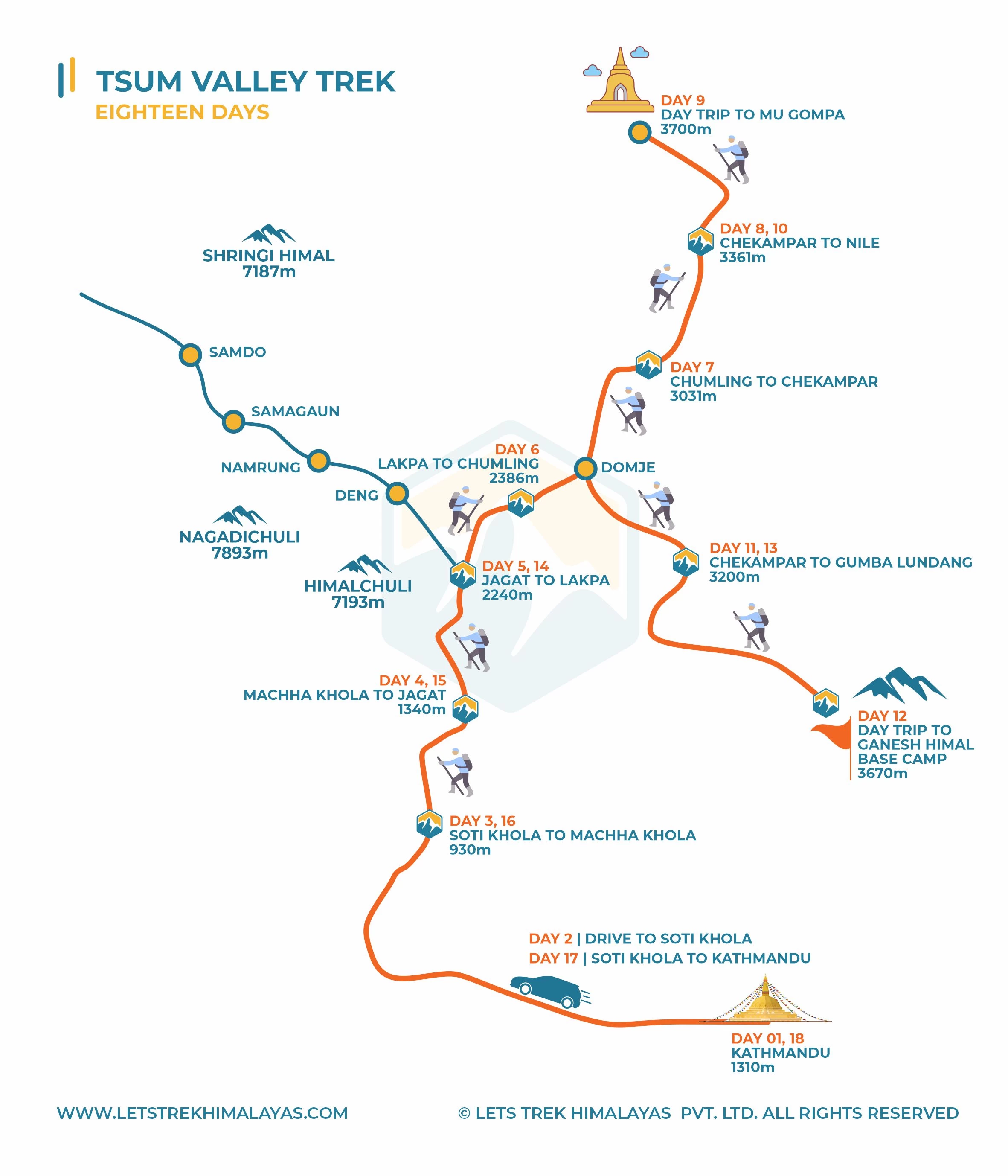Manaslu Tsum Valley Trek is an isolated area of Nepal with pristine nature situated in a Himalayan Terrain. The entire neighborhood has a particular Tibetan Buddhist culture and structure providing life to the valley and is highly distinct from the neighboring farmland. It is located in the Manaslu region close to the Tibetan border.
The Tsum Valley and Manaslu Circuit travel around Mount Manaslu, the eighth-highest mountain in the world, we can experience numerous ethnic settlements and revered Buddhist sites. The prime location to visit is Tsum Valley, which forms a part of the Manaslu Conservation Area and is home to the native Tsumba people with their unique culture. The name, "Tsum," signifies vibrant in the original Tibetan language. It is surrounded by the spectacular Ganesh Himal, Sringi Himal, and Boudha Ranges. Most locals are of Tibetan descent and communicate a distinctive language.
Tsum Valley Trek was made accessible for hiking in 2008, however, there isn't much documentation about the region. Trek to Tsum Valley is in the northern Gorkha district of Nepal, with a holy Buddhist pilgrimage valley in the Himalayas. This tranquil Himalayan valley is rich in delicate tradition, culture, and religion.
Buddhism has an ancient legacy in the Tsum Valley. It is thought that Milarepa, a Buddhist saint, meditated in one of these cliffs and caves. The valley was historically a geographical region with a separate culture known as "Tsum Tso Chuksum," which denotes thirteen provinces governed as a unified realm. The old Tsum Kingdom ruins are still discernible today.
Tsum Valley provides trekkers the chance to see Tibetan Buddhist villagers, monks, and novices in their separate religious orders, as well as the breath-taking Himalayan views on a journey that almost feels like a pilgrimage for those who are interested in Buddhism, Tibetan culture, and the Himalayas.
What To Expect During Tsum Valley Trekking
The Manaslu path is magnificent and unique in terms of culture. From 620 meters to 5160 meters, it presented stunning mountain landscapes and a variety of ecosystems. This trekking route follows the difficult Budhi Gandaki. It passes several cascades, lakes, and fascinating Buddhist monasteries in what appear to be ancient villages.
The trip through the Tsum valley will lead you to a paradise region encircled by the stunning Mt. Ganesh range, which includes Mt. Sringi and Mt. Boudha. The valley doesn't see many travelers because of the terrain's difficulty. This blessed region has only been reached by a very small number of outsiders, and there are still many unanswered questions regarding the valley. On one of the most arduous treks, the off-the-beaten path provides you with the trek of a dream. You will go by thick forests, rushing rivers, breathtaking waterfalls, and historic settlements.
This lovely trip through the secret valley first departs from Aarughat. Additionally, the walk follows the magnificent Budhi Gandaki River. The path resembles the Manaslu Circuit Trek up till Jagat. However, we hike to Chisapani village from there to continue the Tsum Valley route. You continue walking in the direction of the secret Tsum valley while passing through more fascinating towns and thick forests. There are modest hotels with fundamental amenities and services. Nevertheless, the splendor of the expansive vistas and the surrounding communities is extraordinary.
Diversity of Manaslu Tsum Valley Trek
The Manaslu Tsum Valley Trek offers a wealth of opportunities for exploration. Charming settlements along the trail let you observe local Nyingma, Kagyu, and Sakya sect residents' approaches to life and traditions. You also get to watch unusual alpine fauna and vegetation, such as blue sheep, goral, Himalayan tahr, snow leopards, etc.
The route passes through numerous monasteries, Chortens, Stupas, and prayer flags. You'll go to nunneries such Gumba Lunndang, Dephyundonma, and Rachen Gumba. You will also visit Mu Gompa, the oldest monastery in the area. Lakes like Khungyu Lake and Yamdro Lake are also present in the area
Ganesh Himal I (7,422m), Ganesh Himal II (7,118m), and Ganesh Himal IV (7,140m) are three of the seven peaks of the Ganesh Himal Range that may be seen from Gumba Lunndang, one of the greatest spots to see the Himalayas. Locals refer to the Ganesh Himal range as "Yangra." Gumaba Lungdang offers views of neighboring mountains, including Nadi Chuli (7,871m) and Himalchuli (7,331m). The Milarepa Cave monastery at Lamagaun, the footprint of Guru Milarepa (1052-1135), and the majority of the Manaslu region's secret sites are all accessible during the Tsum Valley Trekking.

